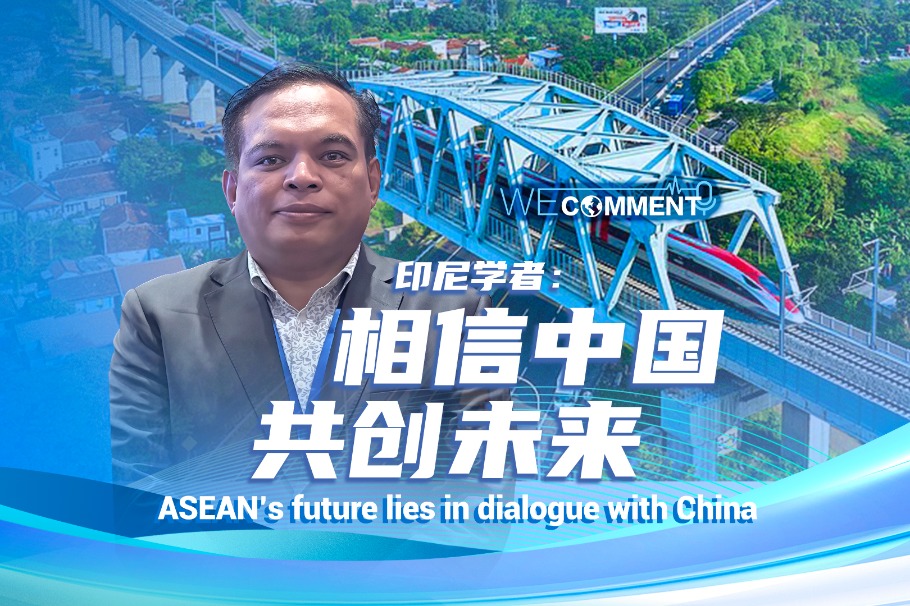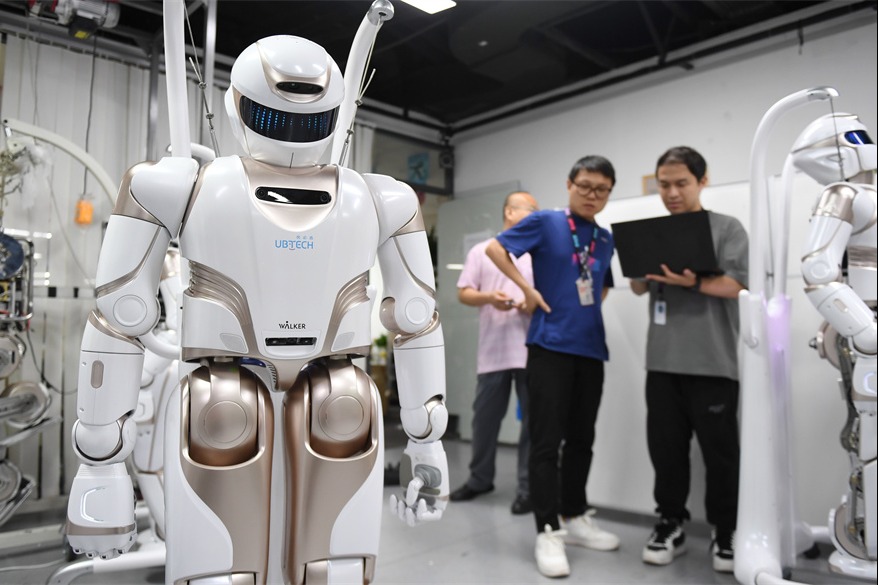Experts call for US-China science cooperation to overcome hurdles
Recent lapse of 45-year research agreement may hamper development of global innovations, they warn
By Lia Zhu in San Francisco | China Daily | Updated: 2024-09-12 07:30

The science and technology relationship between the United States and China has entered a new era of complexity and uncertainty after a 45-year-old agreement, long considered a cornerstone of cooperation, expired on Aug 27.
The US-China Science and Technology Agreement, the first official agreement signed after the normalization of US-China relations in the 1970s, ended despite the scientific community's efforts to have it renewed.
Originally signed by then US president Jimmy Carter and then Chinese leader Deng Xiaoping in 1979, the symbolically significant pact had been renewed every five years since it took effect, with the most recent renewal in 2018.
However, the agreement's fate had been hanging in the balance since August 2023, when it was on the verge of lapsing. In an attempt to salvage the agreement, the two countries extended it twice, for six months each time, to negotiate renewal terms. Those efforts proved unsuccessful, and the most recent six-month extension expired last month.
Many disappointed
The demise of the STA has sparked concern and disappointment among experts in the field.
Richard Dasher, director of the US-Asia Technology Management Center at Stanford University, supports maintaining international cooperation.
"I think we should stay internationally focused. And I think that cooperation is good whenever we can do it. So, in principle, I would be in favor of continuing the US-China Science and Technology Agreement," Dasher told China Daily.
The frustration surrounding the obstacles to renewing the STA is palpable within the scientific community.
Denis Simon, a former professor at Duke University's Fuqua School of Business, and Marcus Stanley, director of studies at the Quincy Institute for Responsible Statecraft, voiced their exasperation by asking, "Why can't we just let American and Chinese scientists get along?"
In an article published in the Quincy Institute's online magazine Responsible Statecraft the day after the agreement expired, the authors emphasized the critical role of the STA in fostering scientific collaboration.
"The STA provided an overarching framework for facilitating scientific exchanges, joint research projects, and the sharing of knowledge and technical expertise," they wrote.
Simon and Stanley warned of the potential consequences of allowing the STA to lapse.
"It would be a mistake for agreements to facilitate basic scientific research cooperation such as the STA to become irretrievably damaged by the increase in US-China tensions. The decision on whether to extend, amend, or terminate the STA has profound implications for the global scientific community," they cautioned.
The authors also highlighted the broader context of growing distrust between the two countries, which has contributed to the current impasse. Besides Congress, the US government has increasingly scrutinized Chinese scientists and researchers over "national security" concerns, which has hampered academic exchanges.
"This climate of growing distrust not only has made renewal of the STA more contentious, but it has also made the rekindling of overall science and technology cooperation more difficult," they said.
Roger Pielke Jr, a nonresident senior fellow at the conservative American Enterprise Institute think tank, expressed his support for continuing the STA "in the most robust form that can be negotiated between the two nations".
He argued that the very existence of such an agreement is more important than its specific details, adding he viewed "decoupling" to be "a bad idea and it is also a bad idea in science and technology".
Crucial support
For decades, the STA has been instrumental in fostering scientific collaboration in areas of basic science such as agriculture, clean energy, public health and the environment. It has provided US and Chinese researchers with crucial financial, legal and political support, enabling them to work together on groundbreaking research and innovations.
Dasher emphasized the interconnected nature of the global scientific community and the importance of collaboration.
"There's a continuum between basic research and actual commercialization, and certainly in the basic research area, there's always cooperation potential, just about everywhere," he said. "And you're seeing a lot of papers written jointly between people in China and in the United States."
The agreement has contributed to a rapid increase in both the number and quality of joint papers by Chinese and US researchers. However, in recent years, research collaboration has declined, attributed to rising tensions and anti-China sentiment.
A study published by the National Bureau of Economic Research in June showed that scientific cooperation between the US and China had drastically decreased since 2016 when the former US president, Donald Trump, took office.
The study analyzed data in three key areas: STEM (science, technology, engineering and mathematics) trainee mobility, use of scientific works between scientists in each country, and scientist productivity in each country as measured by the production of peer-reviewed papers.
Between 2016 and 2019, ethnically Chinese graduate students were 16 percent less likely to attend a US-based PhD program. Moreover, those who did attend such programs were 4 percent less likely to stay in the US after graduation, the study found.
Output drops
The researchers also documented a sharp decline in Chinese use of US science as measured by citations, although they found no such decline in the propensity of US scientists to cite Chinese research.
The trends are corroborated by the State of the Science address delivered by US National Academy of Sciences President Marcia McNutt in June.
McNutt presented data showing that the US is dropping in research output as measured by articles published, while China is experiencing a triple-digit percentage increase. In terms of research quality, measured by the percentage of articles in the top 1 percent cited, the US is losing ground while China has moved ahead of the European Union.
The shifting landscape of scientific productivity is also reflected in the pharmaceutical industry. China's share of drugs in phase one to three trials has risen dramatically from about 3 percent in 2013 to 28 percent in 2021, while the US share is in decline, according to McNutt.
China's number of patents per year surpassed the US around 2015 and is now leading by a ratio of 2 to 1 as of 2021.
In the corporate world, China has emerged as a dominant force, leading the Global Fortune 500 list with 142 out of 500 companies in 2023, a stark contrast to its nonplayer status in 2000.
Those statistics underscore McNutt's conclusion that advancing the frontiers of basic research now requires international partnerships to benefit all researchers.
Saving lives
The importance of such partnerships is illustrated by an example provided by Dasher, involving a medical technology company. He described a collaboration between a senior electrical engineer in Silicon Valley — with innovative ideas for medical image analysis — and a professor in China.
"China has eight times as many medical images as the United States does. So, he cooperated with a professor in China, and the two of them have created a company about medical image analysis to detect cancer," Dasher said.
"That's a very good use, where China has data that is useful for everyone, and we have a technology idea. I think that kind of thing will continue."
The benefits of international cooperation extend to the overall strength of the US technology sector. Dasher said one of the key strengths of Silicon Valley has been its diversity, with 13 percent of the technical workforce born in China.
"We've benefited from foreign people who come to the United States as students and continue to work here. I think that it's also the case where some Americans may want to go to China and work in China. So we need to maintain a very good, safe environment for people to cooperate," he emphasized.
With dwindling government investment, the US industry began taking the lead around 1981 and now dominates US research investment with a 75 percent share, compared with the federal government's 20 percent.
The strengths of the private sector in advancing scientific and technological development, however, have been challenged by the US government's "national security" measures aimed at containing China's development in science and technology.
The biotech industry provides a stark example of the potential consequences of decoupling. Many achievements under the STA, such as US-China collaborations on gene editing research that have created disease-resistant crops and improved yields, are at risk of being reduced to historical footnotes.
Patrick Beyrer, a researcher at the Asia Society Policy Institute's Center for China Analysis, said a potential US-China biotech decoupling is being expedited while everyday Americans aren't adequately prepared for the consequences.
He cited the example of WuXi AppTec as a "research superstore" for its US partners, and WuXi Biologics, the second-largest biologic outsourcer in the world.
Recent policy recommendations from the US House of Representatives' select committee on China have described US dependence on Chinese pharmaceutical supply chains as a "distinct national security risk", with some lawmakers proposing to block Chinese companies, such as BGI Group and WuXi AppTec, from future US federal contracting and government technology procurement.
Impact on treatment
Beyrer warned that the elimination of those companies from US supply chains would have an impact on developing treatments for critical medical conditions, including hearing loss, cystic fibrosis and leukemia.
"In addition to China representing the largest and most cost-effective exporter of active pharmaceutical ingredients to the US market, jointly developed drugs, agricultural technologies, and other biotech-enabled solutions have improved countless American lives," he wrote in an article.
"The collapse of US-China biotech partnerships would spell the end of such jointly developed innovations that harbor the potential to deliver sorely needed global public goods, including saving American lives suffering from diseases such as cancer," Beyrer cautioned.
Talent crunch
The challenges faced by the biotech industry are symptomatic of a broader issue affecting US-China relations in science and technology. Export controls and other measures to restrict technology transfer have moved to the heart of the relationship, increasing tensions between the two countries and posing significant challenges for US tech companies.
Craig Allen, president of the US-China Business Council, criticized the US export controls for causing an "intensely difficult problem" for US tech companies, particularly those that are in Silicon Valley.
"There's a great deal of uncertainty and anxiety. And I think that's true across the board in tech," Allen observed during an event at Stanford while visiting his organization's members in Silicon Valley.
The semiconductor industry, in particular, has been hit hard by these restrictions. Allen said that several US chip companies have recently been banned from selling to an "ill-defined" range of Chinese customers.
"It's becoming more and more difficult to avoid that conflict of law, and thereby the consequences would be terminating or severely restricting what had been a very profitable enterprise for decades," he said.
He emphasized the importance of China for many technology companies, both as a market and as a source of talent.
"China's extremely important for the tech companies; many of them have a large percentage share of their total sales in China, and many of them draw on that enormous Chinese talent pool in China, and that is not something that they can easily walk away from," he said.
An April report by the Federal Reserve Bank of New York estimated that in a small subset of tech companies studied, $130 billion of market capital was lost due to export controls. When new export controls were announced, employment in affected companies declined by 7 percent.
"It is especially detrimental for American companies when export controls are unilateral, enforced by the American government only on American companies in such cases, and there are many unilateral export controls (that) asymmetrically hurt American firms and long-term American competitiveness," said Allen.
These restrictions are disrupting long-established partnerships and hindering access to crucial talent. Allen cited the case of a US multinational company whose lead scientist in China was denied a visa to visit his own laboratories in the US.
"American companies need to access Chinese talent if they are to remain globally competitive. If American companies are barred from hiring Chinese talent, then other companies will be given a long-term structural advantage that probably over a very short period of time will impact American competitiveness," he argued.
This talent crunch is exacerbated by the US' dependence on international students to meet its STEM workforce requirements, as noted by McNutt in her June address. The narrowing channel for data flows between R&D teams in China and the US is making this challenge more acute every day.
Looking ahead, Allen acknowledged the complex political landscape that companies must navigate.
"We live in a political world; companies have to recognize that a potential future conflict between the United States and China would make it impossible for most international trade and investment to continue," he said.
"While conflict is certainly not inevitable, tensions need to be managed carefully, as we try to nudge our way to a more sustainable rules-based multipolar order."
























